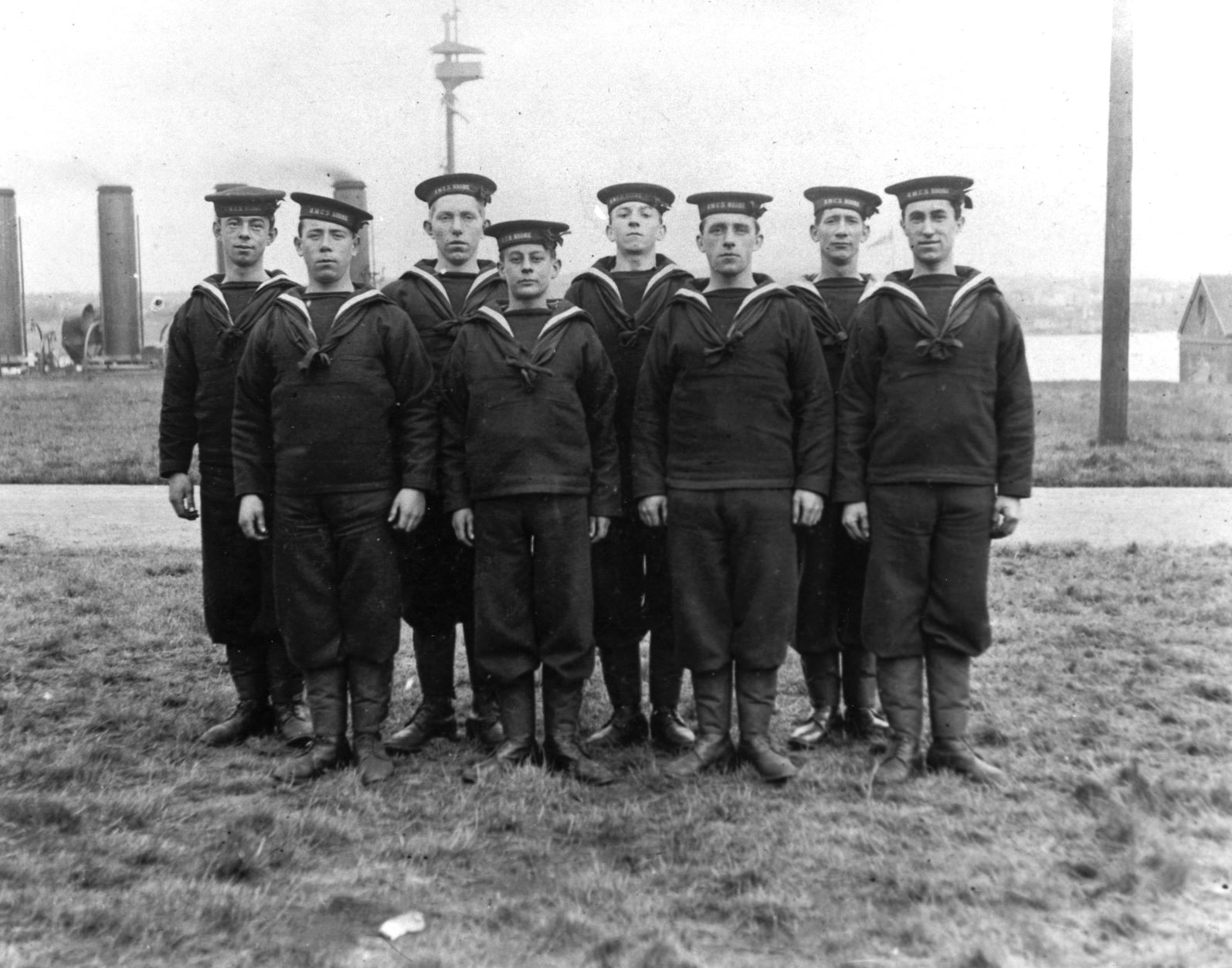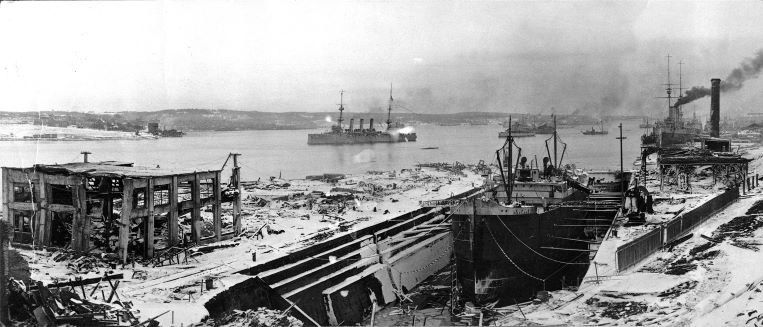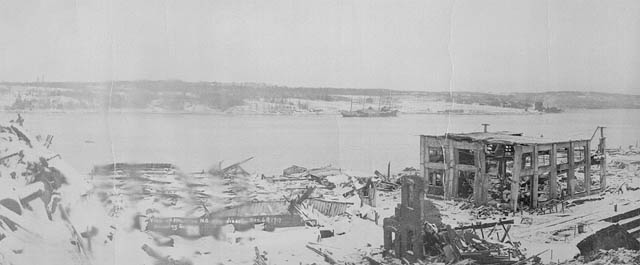His Majesty’s Canadian Ship (HMCS) Niobe was a 11,000-ton Diadem-class heavy protected cruiser, which was originally commissioned into Britain’s Royal Navy. In 1910, Britain sold the vessel to Canada, where it became one of the first two warships of the new Royal Canadian Navy. Niobe saw a few years’ service, including briefly during the First World War. In 1915, due to the ship’s deteriorating condition, it was tied up in Halifax’s naval dockyard and used as a depot ship.

HMCS Niobe
HMCS Niobe was an 11,000-ton lightly armoured cruiser of the Diadem class, which became one of the first two warships of the Royal Canadian Navy.
(Courtesy Library of Congress)
Royal Navy Service
Niobe was built by Vickers Limited at Barrow-in-Furness, England, and launched on 20 February 1897. It entered service as a Royal Navy (RN) warship in 1898 and was one of eight in the Diadem class. Niobe was part of the (English) Channel Squadron when the Boer or Second South African War broke put in late 1899, and it escorted troop ships carrying reinforcements to the war. Niobe returned to its English Channel duties after the war but also escorted ships to some of the far reaches of the British Empire.
HMCS Niobe: Specifications
| Displacement | 11,126.5 tonnes |
| Length | 142 m |
| Beam (Width) | 21 m |
| Draught | 8 m |
| Speed | 15–17 knots |
| Crew | 705 |
| Armament | 16x6-inch guns, 12x12-pounder guns
5x3-pounder guns, 2x18-inch torpedo tubes |

HMCS Niobe Crew
The first group of recruits from Nova Scotia for HMCS Niobe pose in their new uniforms, c.1910.
(Courtesy Naval Museum of Halifax)
Royal Canadian Navy Service
After several years of debate within Canada and discussions with British authorities, the Naval Service of Canada was created on 4 May 1910. A year later, in August 1911, it was renamed the Royal Canadian Navy (RCN). Canada purchased its first two warships from Britain even before the navy was officially established. Rainbow was bought in November 1909 for the west coast. In January 1910, Canada bought the newer and much larger Diadem-class cruiser Niobe for the east coast for £215,000. The RN also agreed to loan Canada 50 officers and more than 500 sailors to operate the cruisers and train Canadian recruits.
HMCS Niobe steamed into Halifax Harbour on 21 October 1910, known as Trafalgar Day in the RN, escorted by two Canadian government fisheries protection vessels. Decked out in flags and bunting (known as “dressed” in nautical terms), Niobe fired her guns to salute her new home port. Cannons mounted on the ramparts of the Citadel, the fortress overlooking the harbour, fired a welcome in response.

HMCS Niobe
HMCS Niobe enters Halifax Harbour on Trafalgar Day, 21 October 1910.
(Courtesy Naval Museum of Halifax)
Did You Know?
Trafalgar Day marks the anniversary of the 1805 victory of a Royal Navy fleet commanded by Admiral Horatio Nelson over the combined French and Spanish fleets. The battle took place off Cape Trafalgar on the coast of southwestern Spain during the Napoleonic Wars. The victory established British naval supremacy and ended Napoleon’s plans to invade England. HMCS Niobe’s arrival at Halifax was carefully timed to coincide with the 105th anniversary of the famous battle.

HMCS Niobe
Exercising a gun crew aboard HMCS Niobe, c.1911. The lieutenant controlling the practice has adopted a convenient position for observing the fall of shot and directing the gun crew.
(Courtesy Naval Museum of Halifax)
Louis-Philippe Brodeur, the minister of marine and fisheries, announced the cruiser’s arrival as “a dawning epoch of self-reliance.” In his flowery rhetoric, Niobe would “plant the standard of progress and true Canadian national greatness upon the virgin slopes of a glorious future that unrolls its splendid proportions before our vision today.”
It was fortunate the RN had agreed to loan sailors to the RCN, since the entire strength of the navy at the time was only 350 officers and men. The warship’s career almost came to an inglorious end when it ran aground on dangerous ledges off Cape Sable at the southwestern tip of Nova Scotia on the night of 30–31 July 1911. The ship was nearly lost before rescue efforts succeeded in floating it free. It took until the end of 1912 before the resulting damage was repaired.

HMCS Niobe in Drydock
HMCS Niobe in drydock at Halifax for repairs and maintenance.
(Courtesy Departmentof National Defence)
First World War
Prior to the outbreak of the war in August 1914, Niobe was employed on coastal patrols, but continuous breakdowns kept it in Halifax for long periods of maintenance and repairs. When the war began, Canada gave operational control of Niobe to the RN. To prepare the ship to go to sea, additional sailors were needed. They were quickly transferred from elsewhere, including more than 100 sailors from the Royal Naval Reserve in St. John’s, Newfoundland.
Niobe’s first operational mission was to escort a troopship carrying the Royal Canadian Regiment from Halifax to Bermuda in September for garrison duty. Later that fall, Niobe joined the RN’s 4th Cruiser Squadron, which was based in Bermuda. Niobe assisted in the blockade of 38 German merchant ships that had sought protection in the neutral American harbour of New York City.

Church Service on the HMCS Niobe
Sunday church service aboard HMCS Niobe as it helps enforce the blockade off New York City, 1914. A merchant vessel steams by in the background.
(Courtesy Naval Museum of Halifax)
This monotonous task involved stopping, boarding and searching every ship for cargo destined for Germany or for German citizens who were attempting to get home to assist in the war. Every 16 days, Niobe returned to Halifax to load fresh provisions and coal. By July 1915, Niobe’s condition had deteriorated, and it returned to Halifax.
Although a major refit was necessary to make Niobe seaworthy, the ship was too old to make it cost-effective. It never put to sea again and was tied up in the naval dockyard, where it was used as a depot ship for accommodation and offices.

HMCS Niobe
HMCS Niobe was used as a depot ship in Halifax when it could no longer put to sea.
(Courtesy Naval Museum of Halifax)
Halifax Explosion
At 8:45 a.m. on 6 December 1917, the French munitions ship Mont-Blanc collided with the Norwegian freighter Imo in the narrowest part of Halifax Harbour. This caused a fire on Mont-Blanc’s deck, and the crew quickly abandoned ship, which then drifted toward Pier 6. Sailors on Niobe spotted the fire, and the ship’s captain sent his steam pinnace (ship’s boat) with seven volunteers to assist Mont-Blanc.
At 9:05, Mont-Blanc exploded in the largest man-made, nonnuclear explosion in history. The force of the explosion blew Niobe’s pinnace and its crew to pieces. The two sailors in charge of the boat received the Albert Medal posthumously. The explosion also badly damaged Niobe, but it was repaired and continued as a depot ship. Niobe was sold for scrap in 1920 and broken up in Philadelphia two years later. (See Halifax Explosion.)

HMCS Niobe and the Halifax Explosion
The Halifax Explosion of 6 December 1917 devastated the city’s naval dockyard and badly damaged HMCS Niobe , making smoke on the right of the photograph.
(Courtesy Naval Museum of Halifax)
Commemoration
October 21, Trafalgar Day, is the RN’s most important annual commemoration and was also celebrated by the RCN. Since 2014, Trafalgar Day has been known in Canada as Niobe Day to reflect the RCN’s roots. In 2010, Canada Post issued a stamp bearing a painting of HMCS Niobe to commemorate the centennial of the Royal Canadian Navy.
Niobe’s ship’s bell is held by the Naval Museum of Halifax and is used on special occasions. A 900 kg anchor uncovered in the Halifax dockyard in 2014 was identified as one of Niobe’s from its time as a depot ship. In 2016, the Canadian War Museum bought Niobe’s wheel from a museum in Camden, New Jersey.


 Share on Facebook
Share on Facebook Share on X
Share on X Share by Email
Share by Email Share on Google Classroom
Share on Google Classroom









